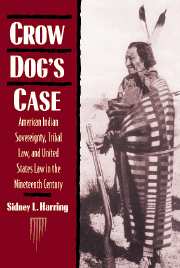 Crow Dog's Case
Crow Dog's Case Book contents
- Frontmatter
- Contents
- Acknowledgments
- 1 “This high pretension of savage sovereignty”
- 2 Corn Tassel: state and federal conflict over tribal sovereignty
- 3 U.S. Indian law and the Indian nations: the Creek Nation, 1870–1900
- 4 Crow Dog's case
- 5 Imposed law and forced assimilation: the legal impact of the Major Crimes Act and the Kagama decision
- 6 Sitting Bull and Clapox: the application of BIA law to Indians outside of the Major Crimes Act
- 7 The struggle for tribal sovereignty in Alaska, 1867–1900
- 8 The legal structuring of violence: U.S. law and the Indian wars
- 9 Conclusion
- Index
8 - The legal structuring of violence: U.S. law and the Indian wars
Published online by Cambridge University Press: 23 September 2009
- Frontmatter
- Contents
- Acknowledgments
- 1 “This high pretension of savage sovereignty”
- 2 Corn Tassel: state and federal conflict over tribal sovereignty
- 3 U.S. Indian law and the Indian nations: the Creek Nation, 1870–1900
- 4 Crow Dog's case
- 5 Imposed law and forced assimilation: the legal impact of the Major Crimes Act and the Kagama decision
- 6 Sitting Bull and Clapox: the application of BIA law to Indians outside of the Major Crimes Act
- 7 The struggle for tribal sovereignty in Alaska, 1867–1900
- 8 The legal structuring of violence: U.S. law and the Indian wars
- 9 Conclusion
- Index
Summary
In a very real sense this whole inquiry is anomalous: every schoolchild in this country knows that the history of the incorporation of the Indian tribes into the United States was one of great violence and illegality. If anything, the real history is worse: the popular images are of parties of armed warriors combating troops of cavalry, not the genocide of starvation, smallpox, tuberculosis, the shooting of villages full of women and children. This genocide is beyond the scope of legal history, but in reality such events reflect U.S. legal choices. The Indian wars were legal events from two perspectives. First, U.S. policymakers' decision to permit settlers to continue pushing back the Indian frontier was the most direct cause of the Indian wars. In its failure to police the frontier effectively, the federal government left a lawless void, whereas Canada, for example, almost entirely avoided Indian warfare by policing frontier whites. Second, the Indians fought wars against whites to enforce their law and protect their legal rights against white illegality. The Indian wars do not reflect “villainy” on the part of the tribes as Justice William Rehnquist asserts in a dissent (conceding “greed, cupidity, and other less than admirable behavior” on the part of the government), disagreeing with the U.S. Supreme Court's weak attempt to redress wrongs committed by the United States against the Sioux in illegally seizing the Black Hills.
- Type
- Chapter
- Information
- Crow Dog's CaseAmerican Indian Sovereignty, Tribal Law, and United States Law in the Nineteenth Century, pp. 251 - 281Publisher: Cambridge University PressPrint publication year: 1994


